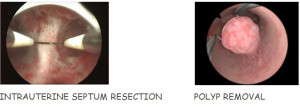What is hysteroscopy?
Hysteroscopyis a procedure to look inside your uterus. It is done using a narrow tube-like telescope with a camera called a hysteroscope, which is inserted into the vagina to examine the cervix and inside of the uterus. Hysteroscopy can be either diagnostic or operative.
What is diagnostic hysteroscopy?
Diagnostic hysteroscopy is used to diagnose problems of the uterine cavity. It can sometimes be clubbed with laparoscopy [In laparoscopy, your doctor will insert an endoscope (a slender tube fitted with a fiber-optic camera) into your abdomen, through the navel, to view the outside of your uterus, ovaries and fallopian tubes.]
What is operative hysteroscopy?
Operative hysteroscopy is used to correct an abnormal condition that has been detected during a diagnostic hysteroscopy. If an abnormal condition is detected during the diagnostic hysteroscopy, an operative hysteroscopy can often be performed at the same time, avoiding the need for a second surgery. During operative hysteroscopy, small instruments used to correct the condition are inserted through the hysteroscope.
Why it is done?
A hysteroscopy may be done to:
- Find the cause of severe cramping or abnormal bleeding.
- See whether a problem in the shape or size of the uterus or if scar tissue in the uterus is the cause of infertility
- Look at the uterine openings to the fallopian tubes. If the tubes are blocked, your doctor may be able to open the tubes with special tools passed through the hysteroscope (tubal cannulation)
- Find the possible cause of repeated miscarriages. Other tests may also be done.
- Find and remove a misplaced intrauterine device (IUD)
- Find and remove small fibroids or polyps
- Look for endometrial cancer
- Use heated tools to remove problem areas in the lining of the uterus (endometrial ablation)
- Place a contraceptive implant (such as Essure) into the opening of the fallopian tubes as a method of permanent sterilization
- Determine the cause of unexplained bleeding or spotting in postmenopausal women

When is operative hysteroscopy used?
Your doctor may perform hysteroscopy to correct the following uterine conditions:
- Polyps and fibroids: Hysteroscopy is used to remove these non-cancerous growths found in the uterus.
- Adhesions: Also known as Asherman’s Syndrome, uterine adhesions are bands of scar tissue that can form in the uterus and may lead to changes in menstrual flow as well as infertility. Hysteroscopy can help your doctor locate and remove the adhesions.
- Septums: Hysteroscopy can help determine whether you have a uterine septum, a malformation of the uterus that is present from birth.
- Abnormal bleeding: Hysteroscopy can help identify the cause of heavy or lengthy menstrual flow, as well as bleeding between periods or after menopause. Endometrial ablation is one procedure in which the hysteroscope, along with other instruments, is used to destroy the uterine lining in order to treat some causes of heavy bleeding.
How safe is hysteroscopy?
Hysteroscopy is a relatively safe procedure. However, as with any type of surgery, complications are possible. With hysteroscopy, complications occur in less than 1 percent of cases and can include:
- Risks associated with anesthesia
- Infection
- Heavy bleeding
- Injury to the cervix, uterus, bowel or bladder
- Intrauterine scarring
- Reaction to the substance used to expand the uterus
When should the procedure be performed?
Your doctor may recommend scheduling the hysteroscopy for the first week after your menstrual period. This timing will provide the doctor with the best view of the inside of your uterus.
What type of anesthesia is used for hysteroscopy?
Anesthesia for hysteroscopy may be local, regional, or general:
- Local anesthesia: The numbing of only a part of the body for a short time
- Regional anesthesia: The numbing of a larger portion of the body for a few hours
- General anesthesia: The numbing of the entire body for the entire time of the hysteroscopy surgery
The type of anesthesia used is determined by where the hysteroscopy is to be performed (hospital or doctor’s office) and whether other procedures will be done at the same time. If you are having general anesthesia, you will be told not to eat or drink for a certain amount of time before the hysteroscopy.
How is hysteroscopy performed?
Prior to the procedure, your doctor may prescribe a sedative to help you relax. You will then be prepared for anesthesia.
The procedure itself takes place in the following order:
- The doctor will dilate (widen) your cervix to allow the hysteroscope to be inserted
- The hysteroscope is inserted through your vagina and cervix into the uterus
- Carbon dioxide gas or a liquid solution is then inserted into the uterus, through the hysteroscope, to expand it and to clear away any blood or mucus
- Next, a light shone through the hysteroscope allows your doctor to see your uterus and the openings of the fallopian tubes into the uterine cavity
- Finally, if surgery needs to be performed, small instruments are inserted into the uterus through the hysteroscope
The time it takes to perform hysteroscopy can range from less than 5 minutes to more than an hour. The length of the procedure depends on whether it is diagnostic or operative and whether an additional procedure, such as laparoscopy, is done at the same time. In general, however, diagnostic hysteroscopy takes less time than operative.
What can I expect after the procedure?
If regional or general anesthesia is used during your procedure, you may have to be observed for several hours before going home. After the procedure, you may have some cramping or slight vaginal bleeding for one to two days. In addition, you may feel shoulder pain if gas was used during your hysteroscopy. However, if you experience any of the following symptoms, be sure to contact your doctor:
- Fever
- Severe abdominal pain
- Heavy vaginal bleeding or discharge
Will I have to stay in the hospital overnight?
Hysteroscopy is considered minor surgery and usually does not require an overnight stay in the hospital. However, in certain circumstances, such as if your doctor is concerned about your reaction to anesthesia or in case of operative procedures, an overnight stay may be required.
When do I call the doctor?
If you have any of the following problems mentioned below:
- Heavy vaginal bleeding or discharge (more than a normal menstrual period)
- Fever
- Fever
- Problems urinating
- Shortness of breath
- Vomiting
References
- American College of Obstetricians and Gynecologists. FAQ: Hysteroscopy. www.acog.org. Accessed 1/25/2013
- American Society for Reproductive Medicine. Laparoscopy and Hysteroscopy: A Guide for Patients. www.asrm.org. Accessed 1/25/2013
- Cain J, ElMasri WM, Gregory T, Kohn EC. Chapter 41. Gynecology. In: Brunicardi FC, Andersen DK, Billiar TR, Dunn DL, Hunter JG, Matthews JB, Pollock RE, eds. Schwartz’s Principles of Surgery. 9th ed. New York: McGraw-Hill; 2010.



